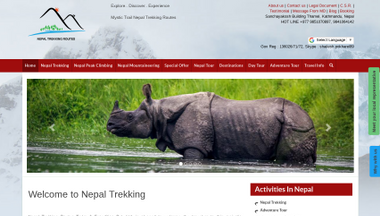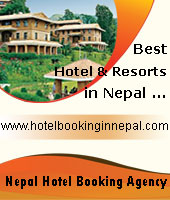South Col – South East Ridge Route – part 3.
Western Cwm between C1 and C2.
Often called the “Valley of Silence,” the Western Cwm (cwm, pronounced coom, is Welsh for a bowl shaped valley/Cirque) is a broad, flat, gently undulating glacial valley basin terminating at the foot of the Lhotse Face of Mount Everest. It is traversed by climbers using the southwest route to the summit of Everest. The central section is cut by massive lateral crevasses which bar entrance into the upper Western Cwm. In this section, climbers must cross to the far right, over to the base of Nuptse to a narrow passageway known as the Nuptse corner. From here, climbers have a stupendous view of the upper 8,000 feet of Everest—the first glimpse of Everest’s upper slopes since arriving at Base Camp. The last 5,000 feet on Everest, including its distinct black pyramid summit, are not visible from Base Camp. Contrary to what most people believe, some of the most difficult days on Everest are in the Western Cwm, when on a windless day it is desperately hot. Temperatures can easily reach 100 degrees Fahrenheit (38° Celsius).
Western Cwm route from camp 1 (top triangle) to camp 2 (bottom triangle) as seen from camp 3 on the Lhotse Face. This area is heavily crevassed and smart teams rope up. It takes about 2-3 hours to walk from C1 (19,500’/5943m) to C2 (21,000’/6400m) and it can be extremely hot.
 For many climbers The Cwm is the first “taste” of Everest. While you still cannot actually see Everest until you go another quarter mile up the Western Cwm, you do have a spectacular view of Pumori and other 7000m hills. I have already described climbing the IceFall so here is a description of the last steps to camp 1.
For many climbers The Cwm is the first “taste” of Everest. While you still cannot actually see Everest until you go another quarter mile up the Western Cwm, you do have a spectacular view of Pumori and other 7000m hills. I have already described climbing the IceFall so here is a description of the last steps to camp 1.
Once you top the ‘Fall there is a large flat expanse of snow. It looks easy but you are tired. Normally climbers take a rest and take some food and water before they continue. You cannot see the actually camp site nor tents from here but you leave anticipating a quick walk. Is always a surprise how meandering the route is since you soon discover that the area is filled with crevasses. This is the end of the Western Cwm and the initial section of the Icefall just before the glacier drops over a steep rock fall to create Khumbu Icefall. Of course all this is hidden by hundreds of feet of ice so all you see is snow, ice and deep cracks.
There are normally five to 8 ladders in this area along with a fixed rope. Climbers are told to always attach themselves to the rope and be extra careful in this area. There is a tendency to relax your guard but now is not the time. The walk has a gradual climb but you soon find yourself breathing hard and looking for the camp. Anywhere from half to a full hour later you make it. The sight of yellow, red or green tents on the pure white snow is amazing. But even more so is the Cwm unfolding in front of you. While not all of it is visible, you can see Nuptse on your right, Lhotse ahead and Everest on your left. Most climbers seem not to notice all this since they are focused on getting into their tents and having a brew and some food. Normally each tent prepares their own food at this camp so it starts to feel like a real climb at last.
Next is the climb to C2 in the Western Cwm.
 It is about 2.5 miles from camp 1 to camp 2 with an altitude gain of 1,500′. So it is not far and not that high but … it is hot, very hot. The sun reflects off the walls of Everest, Lhotse and Nuptse snow covered slopes making the temperature rise above 100F degrees. Yes, it can get that hot. Then it can be brutally cold if the cloud moves in, the wind picks up and it starts snowing. Out comes the Gortex layers and goggles. Smart teams are roped in groups of three or four so that if someone does fall in a crevasse, they can be easily rescued. Finally, if this is the first time in the Cwm, it is an awe-inspiring experience that opens up all your senses.
It is about 2.5 miles from camp 1 to camp 2 with an altitude gain of 1,500′. So it is not far and not that high but … it is hot, very hot. The sun reflects off the walls of Everest, Lhotse and Nuptse snow covered slopes making the temperature rise above 100F degrees. Yes, it can get that hot. Then it can be brutally cold if the cloud moves in, the wind picks up and it starts snowing. Out comes the Gortex layers and goggles. Smart teams are roped in groups of three or four so that if someone does fall in a crevasse, they can be easily rescued. Finally, if this is the first time in the Cwm, it is an awe-inspiring experience that opens up all your senses.
* Source : – http://www.alanarnette.com/
** Previous story :
*** see : Mt. Everets web album
– Routes – part 3.Drogi do celu. cz.3. /Version polish and english/
Droga pierwszych zdobywców Everestu cz.3.
Droga z obozu C1 do C2 czyli Western Cwm.
Mapka na początku pokazuje drogę z obozu C1 (19,500’/5943m) do C2 (21,000’/6400m) poprzez Western Cwm, trasa wiedzie przez Kocioł Zachodni zwany także Doliną Ciszy/Milczenia, bo gdy idzie się Kotłem Zachodnim po dwóch stronach są ściany skalne i jest bezwietrznie. Jest to tylko pozornie prosty etap wspinaczki. W nocy temperatura często spada poniżej zera. W bezwietrzne dni temperatura powietrza, dochodząca do 38°C i palące słońce potrafią być nie do wytrzymania, wielu wspinaczy porównuje to do rozgrzanej patelni. Takie warunki potrafią skutecznie zwolnić tempo marszu u podnóża pokrytej lodowcem ściany Lhotse. Na tej wysokości często zbierają się chmury znad położonych niżej dolin Himalajów. Czasami pojawia się silny wiatr mogący zniszczyć namioty.
Agnieszka Kiela-Pałys, która jako czwarta Polka stanęła na szczycie Świata zdobywając Everest 23 maja 2008 o 5:30, tak opisuję ten etap wspinaczki :
“Drugie wyjście w górę (26-28. kwietnia) – wcale nie było łatwiej, jakoś opadłam z sił. Dwójka znajduje się 300 metrów wyżej niż jedynka (akurat w jej wyprawie takie było położenie obozów -dopisek autora). Idzie się do niej równomiernie w górę po lodowcu w kierunku Ściany Lhotse. Obozy znajdują się na rumowisku skalnym obok mniejszego, choć bardzo aktywnego lodospadu (w nocy schodziły liczne lawiny, a sam lodowiec trzeszczał jak pękające szkło, dostarczając nam dość niezwykłych wrażeń akustycznych). Wszędzie wokół znajdują się fantastyczne formy lodowe. W dzień Kocioł Zachodni rozgrzewa się niemalże do czerwoności, nie na darmo nazywany jest Zachodnim BBQ :-), a w nocy temperatury spadają do -15°C.”
Wyprawa Agnieszki Kiela-Pałys :
– Everest 2008 – z projektu 7summits.pl : Agnieszka Kiela-Pałys czwarta Polka na szczycie Świata cz.1.
– Everest 2008 – z projektu 7summits.pl : Agnieszka Kiela-Pałys czwarta Polka na szczycie Świata cz.2.
* Źródła : – http://www.7summits.pl/ – http://www.alanarnette.com/
** Zobacz też :
– Routes – part 3.Drogi do celu. cz.3. /Version polish and english/
– Everest marzenie wielu… web album
** zapraszam na relacje z wypraw polskich himalaistów.
zapraszam do subskrypcji mego bloga
Filed under: Climbers, Expedition, Himalayas, Routes, Travel | Tagged: Base Camp, Climbers, Edmund Hillary, Everest, Expedition, Kalapatthar, Khumbu glacier, Khumbu Icefall, Lhotse, Nepal, Nuptse, route, South Col, South East Ridge, Tenzing Norgay, Travel, Western Cwm |
































Leave a comment